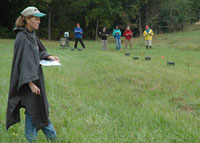A new study shows that frog population estimates may be inaccurate.
Click image to enlarge The “Ribbit Radio” field study revealed that even expert observers make mistakes when identifying frog calls. Photo courtesy North Carolina State University. |
The largest amphibian monitoring program in the United States, created by the U.S. Geological Survey, may be flawed, according to a new study from North Carolina State University.
Amphibian species are sensitive to environmental changes, such as pollution, and scientists monitor their populations to identify potential environmental problems.
Created by the USGS in the 1990s, the North American Amphibian Monitoring Program uses a network of citizen volunteers across the nation to identify local amphibian species by their breeding vocalizations or calls. Volunteers enter the data they collect into the NAAMP database, providing information on the species found and population estimates.
The North Carolina State University study, published in the August issue of Ecology, used “Ribbit Radio” to determine how well observers could identify frog species. Ribbit Radio consists of a series of remotely controlled playback devices that can be used to mimic populations of calling frogs. The system was set up in a field, and researchers immediately found that many observers noted false positives, meaning they said they heard species that were not played by the Ribbit Radio setup.
The study indicates that if false positives remain unaccounted for in the NAAMP’s program, frog population estimates could be severly overestimated. The NAAMP, which participated in the study, plans to conduct a follow-up study with Ribbit Radio and North Carolina State University researchers this fall.
Ribbit Radio has been previously used as “Bird Radio” to test the accuracy of bird census methods.



